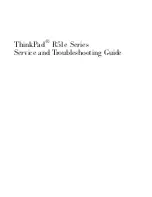
Light and Materials
303
❚❘❘
components are responsible for different lighting
effects.
There are two types of diffuse reflection—uniform
diffuse and directional diffuse.
Uniform diffuse reflec-
tion
accounts for light that is scattered uniformly in all
directions. In
directional diffuse reflection
, sometimes
called
specular highlight
, the light leaves the surface at
various angles. Directional diffuse reflections do not
provide clear reflections. Instead, they provide high-
lights, such as the bar of shininess on a door knob
where the light hits it at the right angle.
For most rendering techniques, you do not need to
understand the consequences of directional diffuse
reflection. It can only be calculated when ray tracing
and refining shadows using the high-quality reflec-
tion model. For more information, see “High-Quality
Reflection Model” on page 306.
In specular reflection, the light being reflected leaves
the interface at the same angle at which it arrived.
Specular reflections provide clear reflections off shiny
surfaces, such as seeing an object reflected off a tiled
wall. A mirror is a perfectly specular surface; that is,
all of the light reflected at the interface is reflected in
the specular direction.
Lightscape uses the shininess of the material, the
angle of the incident light hitting it, and the index of
refraction to determine the proportions of specular
and diffuse reflection. (The angle of the light, of
course, is not a property of the material itself, but of
the geometry of the object using the material.) The
shinier the material or the closer the angle comes to
grazing the material, the larger the component of
specular reflection.
The specular component is responsible for the clear
reflections off shiny materials, as well as the images
seen through transparent materials. A shiny material
has more of a specular reflection when ray traced and
has a sharper highlight when shadows are refined. For
more information, see Chapter 14, “Rendering.”
As a material becomes less shiny, more of the energy
is reflected and transmitted in the non-specular
directions, until the material becomes very rough and
most of the energy is reflected and transmitted
diffusely (uniformly in all directions). The following
illustration shows the proportion of diffuse reflection
as a bubble of light.
Diffuse reflection
Specular reflection
Reflection and transmission from
materials of different roughness
Shiny (glossy paint)
Medium-rough
(semigloss paint)
Very rough (matte
paint)
Summary of Contents for LIGHTSCAPE
Page 1: ...SULO 4 31 93 36034333308355 LJKWVFDSH...
Page 18: ...NOTES 10...
Page 110: ...NOTES 102...
Page 136: ...NOTES 128...
Page 166: ...NOTES 158...
Page 176: ...NOTES 168...
Page 202: ...NOTES 194...
Page 210: ...NOTES 202...
Page 248: ...NOTES 240...
Page 294: ...NOTES 286...
Page 308: ...NOTES 300...
Page 316: ...NOTES 308...
Page 324: ...NOTES 316...
Page 342: ...Glossary 334 Lightscape...
Page 360: ...Index ix 352 Lightscape...
Page 362: ......
















































